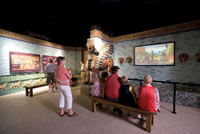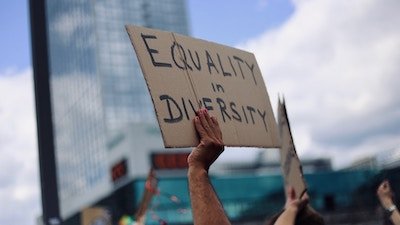Race Around the Nation
Special exhibition on races/racism travels across America through 2014
A special exhibition on racism and the “races” is traveling across America. While interesting, there some glaring oversights included.
Even after examining the same evidence, and also recognizing the biases that are brought to the table about studying the unobservable past, creationists and evolutionists can, on occasion, come to the same conclusion about human origins.
That’s one of the positive aspects of the traveling exhibition called “RACE: Are we so Different?,” which opened in Cincinnati, Ohio (near Answers in Genesis), over the weekend. It launched just before Martin Luther King Jr. Day (today, Monday) and the inauguration of Barack Obama on Tuesday.1
Housed inside the architecturally stunning Cincinnati Museum Center, the temporary exhibition poses the question: “Are we so different?” The query itself yields a clue to what the central message is of the well-done (but perhaps too wordy) exhibition—and hints at whether we should even be questioning the concept of races at all. (It should be pointed out that there is some relevance to having “RACE: Are we so Different?” in Cincinnati, as this community continues to wrestle with issues lingering from a 2001 “race” riot.)
One of the first displays declares (as we do inside our Creation Museum) that among humans, there are no races except the human race. Furthermore, a nearby exhibit poses and answers the question: “Does skin color equal race?” The answer, too, could have been given by the biblical creationist, as the display declares: “Race and skin color are often linked, but neither color nor any other trait distinguishes people of one so-called race from another.”
Close by, the visitor reads a quote from Melvin Oliver of the University of California–Santa Barbara, who adds to the exhibit’s one-race theme: “The things we identify as racial markers—skin color, hair texture, and the rest—mean nothing unless they are given social meaning and unless there is public policy and private actions that act upon those kinds of characteristics.” Again, no disagreement.

Click to enlarge
The entrance to the “RACE: Are we so different?” exhibition. (Photography is not allowed inside.)
To cap off this portion of the exhibition, geneticist Kenneth Kidd of Yale is cited:
“Our studies of genetic diversity give us an even greater understanding of how similar we are in our marvelous variation. The variation that makes each of us genetically unique represents a fraction of one percent of what makes us.”
That would be the end of our review right there, and we would be largely content with “RACES: Are we so Different?” But exhibit developers apparently felt the needed to add more “scientific” content (read: evolution) and thus perhaps lend more authenticity to the claims. Sadly, as visitors continue on a walk through the exhibit area, they notice that evolution is often mentioned and misused as the supposed driving force behind the creation of sub-groups of people within the one human race.
For example, Penn State University anthropologist Nina Jablonski states in one display:
“Over the course of evolution, human ancestors became bigger and more active as they moved into hot, open environments in search of food and water. . . . In these places, one big challenge was keeping cool. The adaptation they made was to increase the number of sweat glands on their skin while at the same time reducing the amount of their body hair. But this less-hairy skin was a problem because it was exposed to very strong sun light, especially in lands near the equator. The solution was to evolve skin that was permanently dark so as to protect from the Sun’s more damaging rays. So our prehistoric ancestors probably had nearly hairless bodies and dark skin.” [emphasis added]
Note the use of the words made and solution. Jablonski’s comments suggest that our ancestors had the ability to make additional sweat glands, and that evolution somehow had the ability to provide the “solution” to the problem of people living in a hot climate. Both words beg the question: how? A mindless, chance process like evolution doesn’t have the ability to solve the challenge of skin and environment.
The evolution content continues throughout the exhibition, including an answer to the question: “Didn’t darker skin evolve to protect us from skin cancer?” Jablonski answers: “No,” but adds that “evolution favors changes that improve reproductive success. Because skin cancer usually affects people after they have had children, it likely had little effect on the evolution of skin color.”
There are three processes of evolution, declares the exhibition, which are responsible for much of human variations: mutations, random genetic sampling (e.g., alleles can, by chance, become more or less common in a population), and natural selection. In another museum exhibit, an evolutionary timeline is worked into the story of race, with the question: “How are we alike?” It features a map that discusses human migration going back over 200,000 years (“7,500 generations ago”), which is well beyond the biblical timeline of 6,000 years for humans; it also states that modern humans supposedly started in Africa. More about these observations in a moment.
Other references to evolution punctuate the displays and videos, but ultimately they add nothing to the exhibition’s goal of promoting racial understanding and reconciliation.
The Bible and “Race”
Working from a biblical worldview, Christians will agree that all humans on earth today are descended from Noah and his wife, their three sons and their wives (and before that from Adam and Eve).2 Noah and his family (a total of 8 people) possessed genes for the variety of skin colors we observe today. The Tower of Babel, a few generations after the Flood, led to a large interbreeding group being divided into small, interbreeding groups. The resulting groups would have different mixes of genes for various physical features. By itself, this dispersion would ensure, in a short time, that there would be certain fixed differences in some of these groups (called “races” today). The environment, as mentioned above, would impact the existing gene combinations so that the physical characteristics of each group would tend to suit their environment.
The people groups went to areas that presented different climates. (After the Flood, the dispersed peoples faced a climate and environment that were drastically altered from the pre-Flood world.) Those who went to colder climates and had dark skin within their group would probably suffer a Vitamin D deficiency, like rickets, for in an area of less sunlight (the skin produces Vitamin D from sunlight), the person would be at a disadvantage. Colder climates would tend to favor those with lighter skin; as a result, dark-skinned people would not be as healthy and have fewer children, and over time, their numbers in the cold region would shrink. The population would eventually become lighter skinned.
Conversely, those with darker skin, who went to warmer areas and its additional sunlight, would cope much better (e.g., skin cancer would be less common), and it would be the lighter-skinned people who would see their population decrease there, and a darker-skinned population would result.
This population shift of becoming lighter or darker should not be called an adaptation in an evolutionary sense, for the population did not develop anything new in its DNA that enabled the people to cope with a new environment. All basic factors for skin color were present in the first created humans, Adam and Eve, and no new genetic information has been added since. The dominant features of the various people groups resulted from different combinations of previously existing created genes (if anything, there could be minor degenerative changes, coming via mutations). The original genetic information found in the first couple has been either reshuffled or gone downhill (degenerated), but has not been added to.

Click to enlarge
This is the Creation Museum’s exhibit area on the Tower of Babel and the origin of the different people groups (the large sign on the left in particular deals with the “races” question).
Ultimately, adaptation to a climate has nothing to do with evolution in the “molecules to man” sense of upward progression.
Another drawback to the exhibition: while it brings up many social injustices related to “race,” it barely touches on racist-inspired genocide. Hitler’s virulent racism is mentioned; much of it was based on Darwinian thinking (“survival of the fittest” as carried out by Nazi Germany), but that connection is omitted. The exhibition chose to concentrate on racial prejudice in America and not the most extreme form of racism: genocide around the world.
Another drawback (and perhaps it’s a surprising one to be offered up by a Bible-upholding ministry like Answers in Genesis): the exhibition barely touches on the shame of the church as it relates to how Christian leaders fostered racism in the culture (which is discussed in the Ken Ham/Charles Ware book Darwin’s Plantation [now printed under the title One Race One Blood]).
Interestingly, for an exhibition that uses scientific research to make its evolutionary claims, it acknowledges one of the negative impacts of previous anthropological research on race relations. The exhibition describes the scientific advances in the 1700s and 1800s when there was great activity to classify all living things. But such work only led to an exacerbation of the physical differences among people and created more of a gulf between people who looked dissimilar. Soon, the word “race” to describe people of different appearance came about. It is a relatively recent invention, says the exhibit. Previously, “race” referred to people groups in countries (e.g., the Irish “race”).
Does the exhibition succeed in its goal of helping “individuals of all ages better understand the origins and manifestations of race and racism in everyday life by investigating race and human variation through the framework of science”?3 Largely, yes, but not as it relates to the ultimate “origins” question of the races, for there is an unfortunate evolutionary backdrop to many of the displays. Evolution, however, adds nothing to the exhibition.
The various subgroups we see around the world today remain virtually identical genetically to each other except for superficial, on-the-surface physical traits like skin shade and type of eyelids. Just as the exhibit concluded that there is really only one race, the human race, it corresponds to the biblical teaching that we are all of “one blood” (Acts 17:26). Scripture distinguishes people by tribal or national groupings, not by skin color or physical appearance. Clearly, though, there are groups of people who have certain features (e.g., skin shade) in common, which distinguish them from other groups. We prefer, though, to call these “people groups” rather than “races.” Using the words people groups also helps avoid the evolutionary baggage often associated with the word race.

Click to enlarge
This stunning Art Deco building in Cincinnati (formerly a large train station) houses three museums and an Omnimax theater. It currently hosts a traveling exhibition on races.
The Bible is actually confirmed by science and this special exhibition when it’s shown that the DNA of any two people in the world would typically differ by much less than one percent. Accordingly, we should not be surprised that all people are classified by biologists as belonging to one species: Homo sapiens.
Over the next several years, this traveling exhibition will stop in many other cities, with Philadelphia and Los Angeles coming later this year. I am biased, of course (we all are when it comes to our thinking of human origins), but the best exhibit in our region on anthropology—plus one that provides the only true remedy for racism (the Bible’s teachings)—is found inside our Creation Museum. For all the positive elements that can be found in “RACES: Are we so Different?,” the exhibition pales in comparison to what is presented in the Creation Museum, both in its science and in its worldview.
Editor’s note: The Cincinnati Museum Center is now preparing its next major exhibit—on dinosaurs. It will doubtless be presented in an evolutionary context (as its promotional material suggests). We hope that visitors to this dinosaur show will make the 25-minute drive to the Creation Museum in northern Kentucky where an impressive array of animatronic dinosaurs and other exhibits present a different—and more satisfying—explanation about the origin and disappearance of these magnificently designed creatures.
Footnotes
- President Obama is sometimes described as “biracial” (his mother was a light-skinned woman from Kansas), though he apparently does not care for the term.
- Some Christians will argue (often because they are racists) that God created other races separate from the so-called “Caucasian” race that started with a light-skinned Adam and Eve. For example, see A Different Perspective.
- http://www.understandingrace.org/about/brochure.pdf; the sponsors of this exhibition are listed here as well.
Recommended Resources

Answers in Genesis is an apologetics ministry, dedicated to helping Christians defend their faith and proclaim the good news of Jesus Christ.
- Customer Service 800.778.3390
- Available Monday–Friday | 9 AM–5 PM ET
- © 2025 Answers in Genesis







